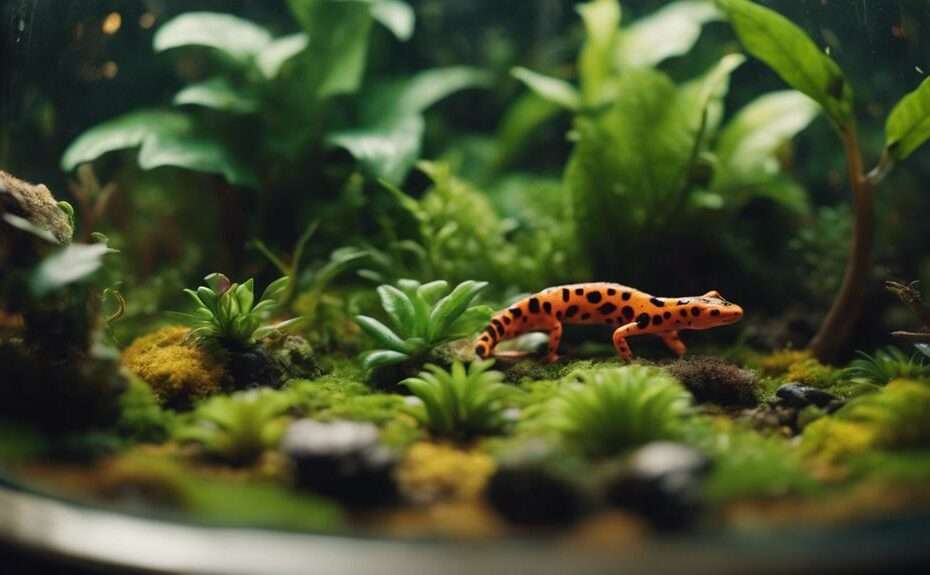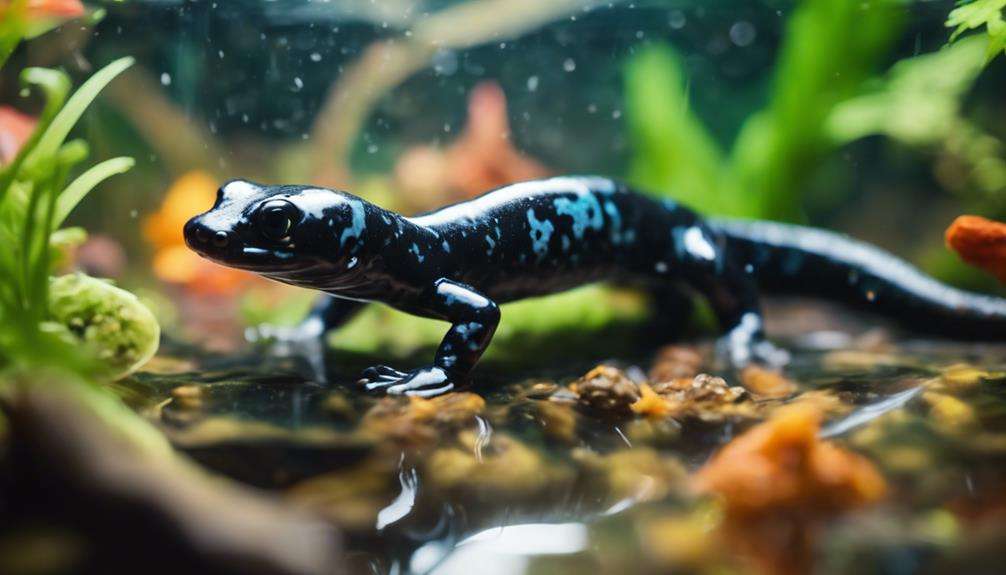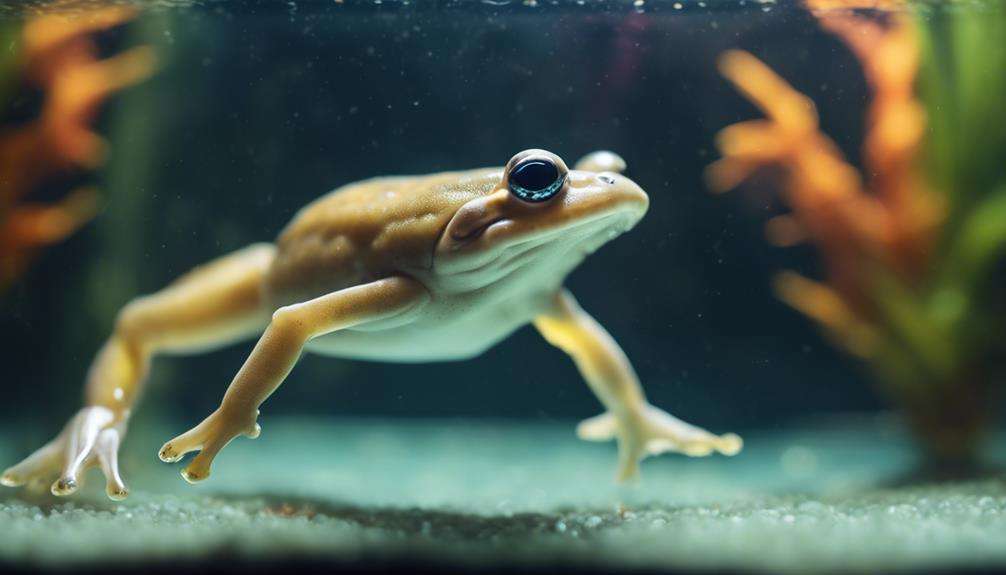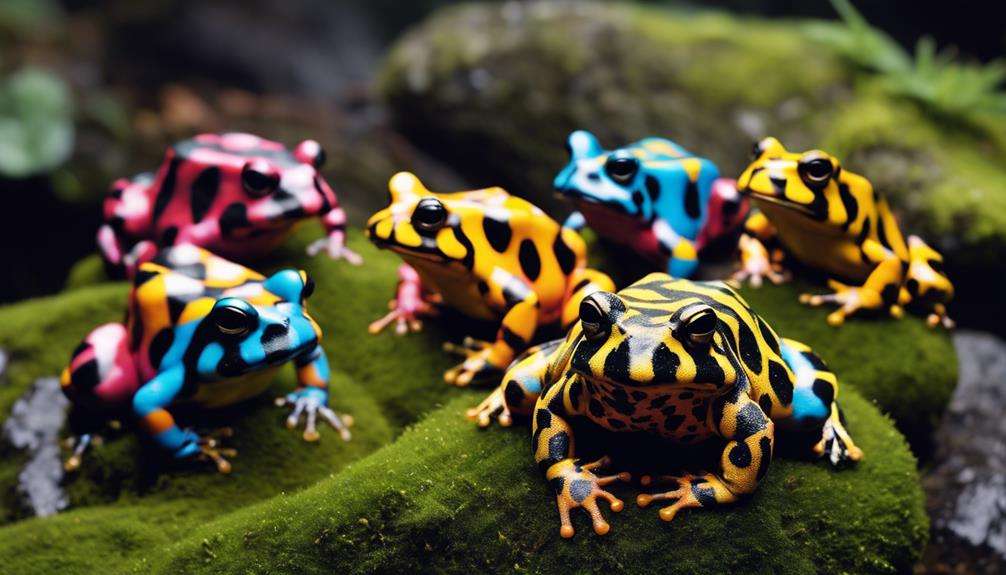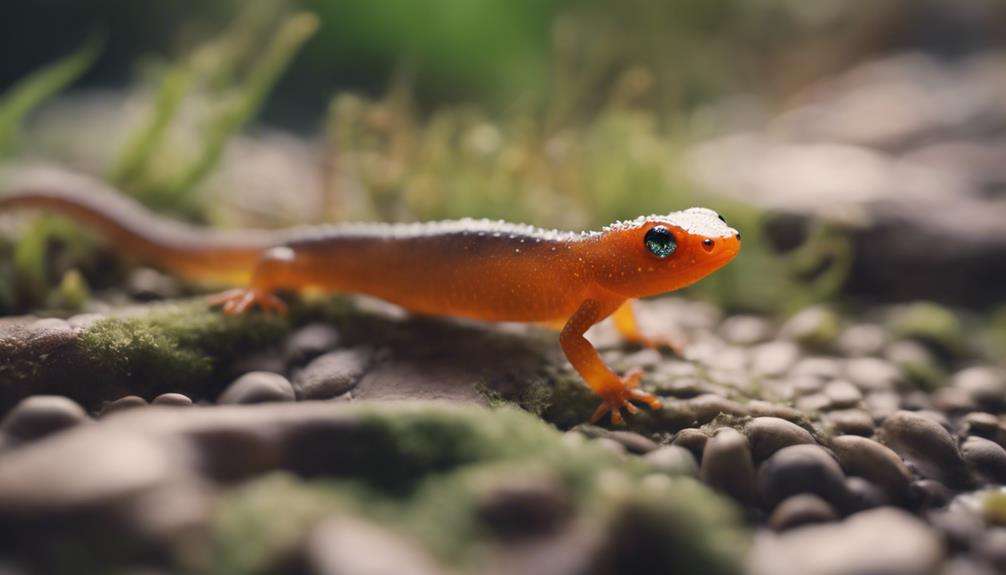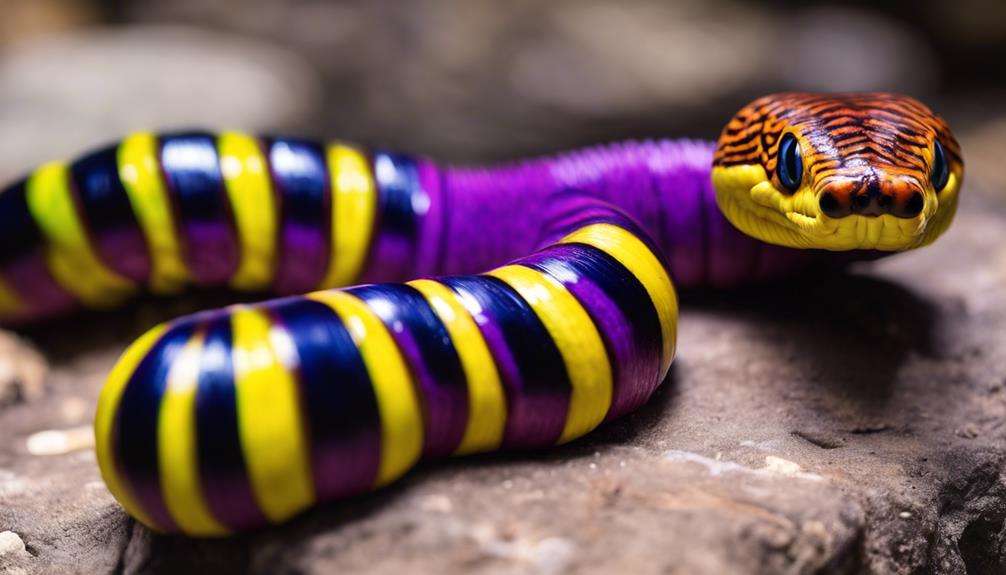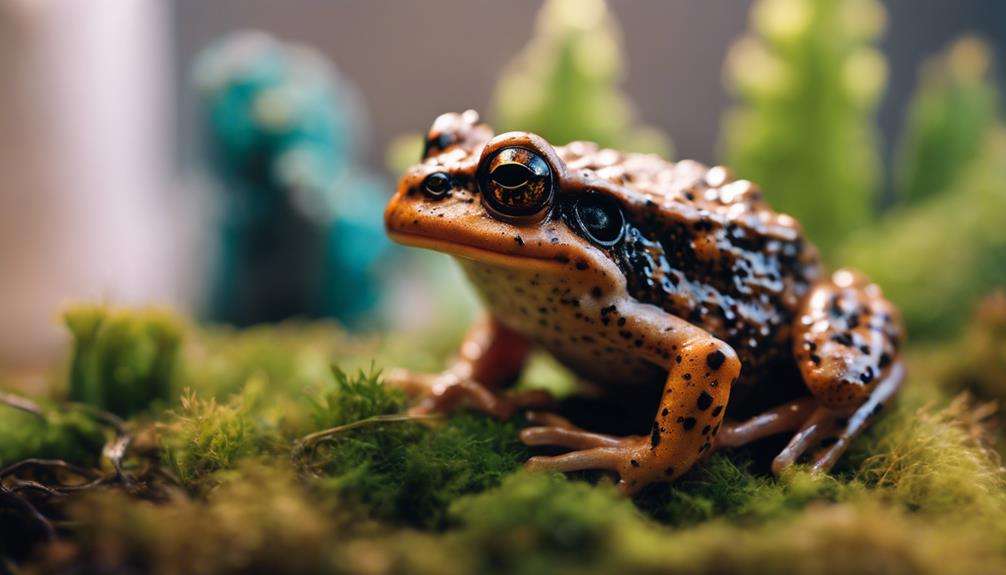If you've ever marveled at the intricate beauty of a marbled salamander, you might have wondered why these creatures are considered ideal for terrariums. Their allure extends beyond their striking appearance.
Salamanders possess a remarkable ability that adds an intriguing element to terrariums, making them a fascinating choice for enthusiasts looking to create captivating and dynamic miniature ecosystems.
So, what is it about these amphibians that sets them apart in the world of terrarium keeping?
Key Takeaways
- Salamanders mimic natural habitats in terrariums, providing comfort and security.
- Their low-maintenance care and simple dietary needs make them ideal for terrarium enthusiasts.
- Salamanders' adaptability, behaviors, and unique features simplify terrarium maintenance tasks.
- They thrive in stable terrarium ecosystems, showcasing versatility and ease of care.
Benefits of Keeping Salamanders in Terrariums
Keeping salamanders in terrariums offers numerous advantages, making them an excellent choice for both novice and experienced reptile enthusiasts. When considering the habitat of salamanders, it becomes evident that these creatures are well-suited for terrarium environments.
Salamanders are typically found on the forest floor, where they interact with various elements of plant life. Mimicking this natural setting in a terrarium allows for a close representation of their native habitat, providing a sense of comfort and security for the salamanders.
Salamanders as Low-Maintenance Pets
In considering the care requirements for salamanders, their status as low-maintenance pets becomes evident due to their minimal grooming needs and simple dietary preferences. Salamanders are well-suited for terrarium environments, requiring only a shallow water dish for hydration as they absorb moisture through their skin. This eliminates the need for frequent water changes or complex filtration systems. The terrarium setup should include a substrate that retains moisture, such as coconut fiber or sphagnum moss, to maintain adequate humidity levels for the salamander's skin health.
Feeding salamanders is straightforward, with a diet primarily consisting of insects like crickets, mealworms, and earthworms. These prey items can be easily obtained from pet stores or bred at home, reducing the hassle of sourcing specialized food. Salamanders aren't demanding in terms of feeding frequency, typically requiring meals every 2-3 days depending on their size and species. Their sedentary nature means they don't need extensive exercise or playtime, making them suitable for owners seeking a low-maintenance pet that still offers the joy of observation in a carefully crafted terrarium habitat.
Unique Features of Salamanders for Terrariums
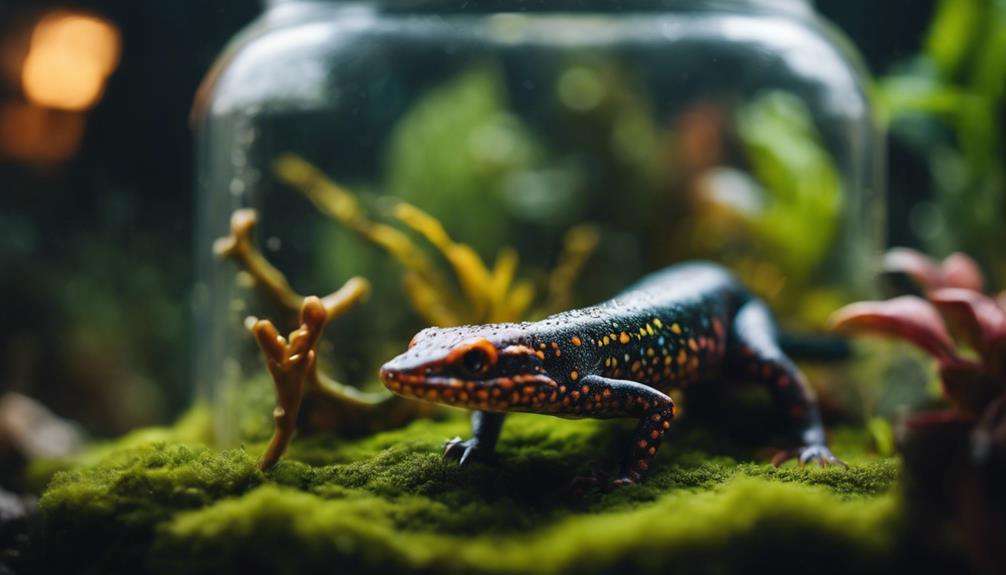
Salamanders possess remarkable adaptability traits that make them well-suited for terrarium environments. Their ability to thrive in various conditions contributes to the ease of maintaining a balanced ecosystem within the enclosure.
Observing their behaviors and interactions with the terrarium surroundings can provide valuable insights into their role in waste recycling and plant health.
Salamander Adaptability
Adapted to thrive in terrarium environments, salamanders possess unique features that enable them to excel in captivity. Their skin, allowing them to breathe through it, suits terrariums with high humidity levels.
Being cold-blooded, they require less heat and energy, simplifying care in terrarium settings. Salamanders' climbing abilities thrive in terrariums with vertical spaces, mirroring their natural behaviors.
Their adaptable diet, ranging from insects to small invertebrates, accommodates various terrarium setups. Engaging in captivating behaviors like burrowing and hunting, salamanders offer entertainment and enrichment in terrarium settings.
These characteristics make salamanders ideal for terrariums, offering enthusiasts a glimpse into the captivating world of these unique amphibians.
Terrarium Maintenance Ease
With their natural proclivity for low-maintenance care and unique physiological adaptations, salamanders present an ease of terrarium maintenance that's unparalleled among amphibians. Salamanders' maintenance ease in terrariums is further enhanced by:
- Efficient Water Management: Salamanders' ability to absorb moisture through their skin reduces the need for frequent watering in the terrarium.
- Natural Pest Control: Their efficient hunting behavior helps in controlling pest populations within the terrarium ecosystem.
- Minimal Structural Needs: Salamanders' natural burrowing and hiding tendencies minimize the requirement for elaborate structures or decorations in the terrarium.
- Adaptability in Environments: Salamanders' adaptability to various temperatures and environments simplifies terrarium maintenance tasks, ensuring a stable ecosystem for these amphibians.
Salamanders' Adaptability to Terrarium Environments
Burrowing into the moist substrate, spotted salamanders display remarkable acclimation to various terrarium conditions. Their adaptability to terrarium setups stems from their diverse habitat preferences. Salamanders thrive in different temperature and humidity conditions, making them well-suited for a range of terrarium environments. Their burrowing behavior and need for hiding spots align with terrarium landscaping, providing ample opportunities for natural behaviors.
Spotted salamanders' ability to adjust to different terrarium conditions allows for a more enriched terrarium experience. Whether the terrarium is set up with a forest-like habitat or a damp, moss-covered environment, these amphibians can adapt and thrive. By providing suitable temperature gradients and humidity levels, you can create a habitat that mirrors their natural surroundings. This adaptability not only benefits the salamanders but also enhances the overall terrarium ecosystem.
Observing how spotted salamanders interact with and respond to various terrarium conditions can offer valuable insights into their adaptability and behavior in captivity.
Salamanders' Natural Behaviors in Captivity
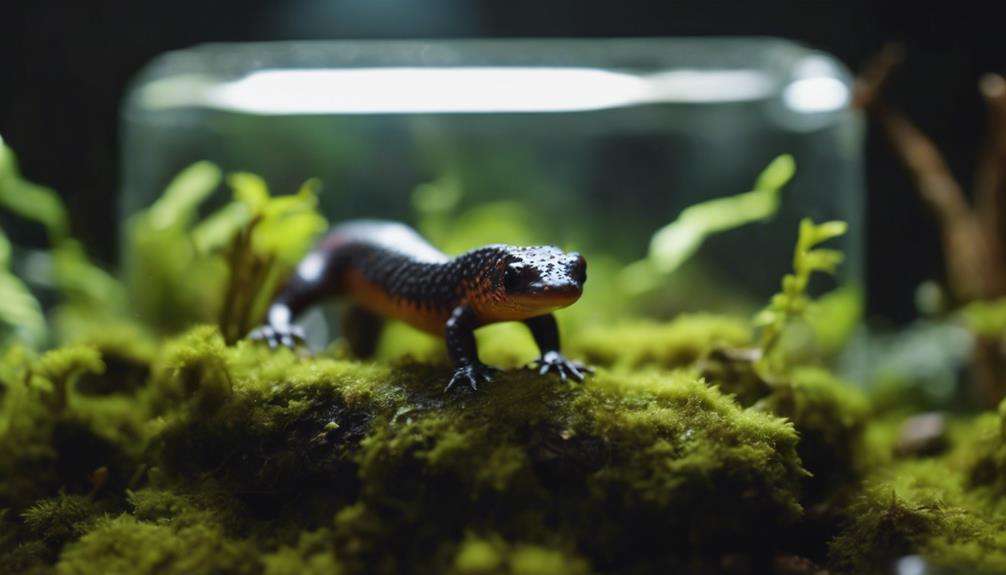
When observing captive salamanders, you can witness their intriguing burrowing behaviors, adding a captivating element to your terrarium setup.
Their natural hunting instincts are on full display as they actively search for live prey within the terrarium environment.
Additionally, salamanders' climbing abilities enable them to explore and utilize vertical spaces within the enclosure, showcasing their adaptability and agility.
Captive Salamander Behavior
Captive salamanders frequently engage in a range of natural behaviors such as climbing, hunting, and exploring their terrarium environment. They interact with various terrarium elements, showcasing behaviors that mimic their natural habitat. Some common behaviors observed in captive salamanders include:
- Burrowing: Salamanders often dig into the substrate to create hiding spots or search for food.
- Territoriality: They establish territories within their enclosure, defending preferred areas from other salamanders.
- Nocturnal activity: Certain species are active during the night, displaying behaviors like hunting and exploring.
- Social interactions: Salamanders may exhibit social behaviors such as mating rituals or group dynamics, providing insights into their social structure.
Terrarium Enrichment Activities
To enhance salamanders' well-being and natural behaviors in captivity, enriching terrarium activities should focus on providing a diverse range of stimuli and environmental elements. Salamanders exhibit behaviors such as burrowing, climbing, and exploring, mirroring their actions in their natural habitat.
By incorporating hiding spots, perching areas, and tunnels within the terrarium, you can encourage these behaviors. Live plants, branches, and rocks offer opportunities for hunting and foraging, stimulating the salamanders' instincts.
Mimicking a natural habitat with varied substrates and textures enhances sensory exploration. Providing basking spots and cooler zones supports thermoregulation, promoting salamanders' activity levels and overall well-being.
Salamanders' Contribution to Terrarium Ecosystems
How do salamanders significantly contribute to the intricate balance of terrarium ecosystems? Salamanders play a vital role in maintaining the ecosystem within terrariums. Here are some ways in which they contribute:
- Nutrient Cycling: Salamanders help in the breakdown of decaying organic matter, releasing essential nutrients back into the terrarium soil for plant uptake.
- Pest Control: By feeding on insects and small invertebrates like fruit flies and springtails, salamanders help control pest populations, ensuring the health of plants and other terrarium inhabitants.
- Behavioral Diversity: Salamanders exhibit a range of behaviors such as hunting, burrowing, and exploring, adding interesting dynamics to the terrarium environment.
- Biodiversity: Interacting with plants, soil, and other organisms, salamanders contribute to the overall biodiversity and health of the terrarium ecosystem.
Through their feeding habits, behaviors, and interactions, salamanders play a crucial role in creating a balanced and thriving terrarium ecosystem.
Salamanders for Educational Display Purposes
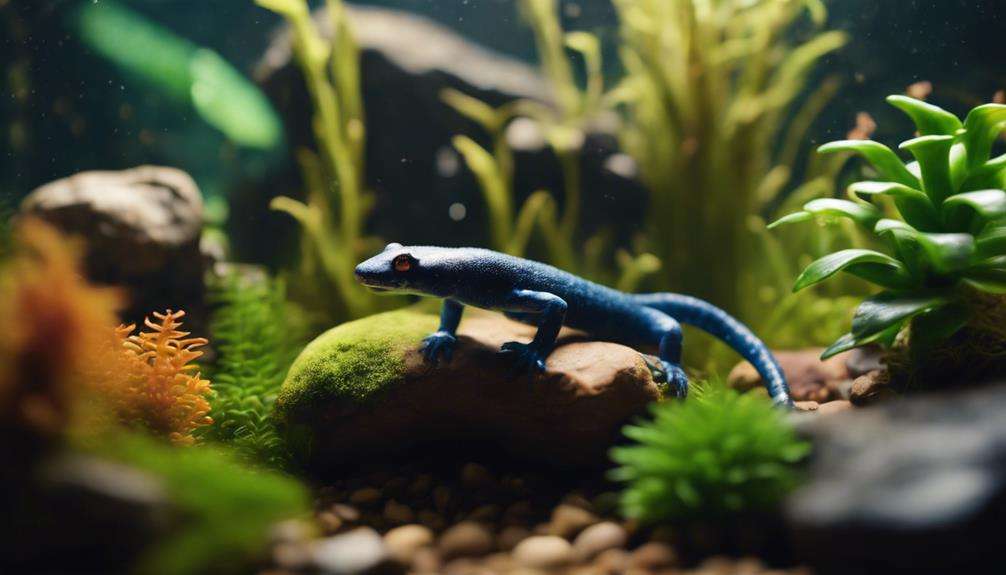
Salamanders' suitability for educational displays stems from their diverse species and unique characteristics, offering a hands-on opportunity for students to closely observe amphibian behavior and biology. By showcasing various species of salamanders in terrariums, educators can create interactive learning environments that enable students to witness firsthand the fascinating features of these creatures.
Through observing salamanders, students can learn about ecosystems, food chains, and environmental conservation, gaining insights into the delicate balance of nature. One remarkable aspect that captivates learners is the salamanders' ability to regenerate limbs and tails, sparking discussions on regeneration and adaptation in biology classes.
Studying salamanders in educational displays not only provides a scientific experience but also instills a sense of curiosity and wonder about the natural world. Ultimately, incorporating salamanders into educational displays can inspire a passion for science, nature, and wildlife conservation among students, fostering a deeper appreciation for the biodiversity present in our environment.
Salamanders' Compatibility With Other Terrarium Species
A well-designed terrarium can accommodate salamanders alongside other non-aggressive species such as certain frogs and small reptiles, fostering a diverse and dynamic ecosystem.
When considering the compatibility of tiger salamanders with other terrarium inhabitants, several key factors must be taken into account:
- Habitat Requirements: Ensure that all species sharing the terrarium have similar environmental needs in terms of temperature, humidity, and substrate type.
- Behavioral Observations: Monitor the interactions between different species to prevent aggression or competition for resources.
- Space Availability: Provide enough space and hiding spots to prevent overcrowding and allow each species to establish their territories.
- Dietary Considerations: Be mindful of the varied diets of different species and ensure that each one receives appropriate nutrition.
Salamanders' Popularity Among Exotic Pet Owners
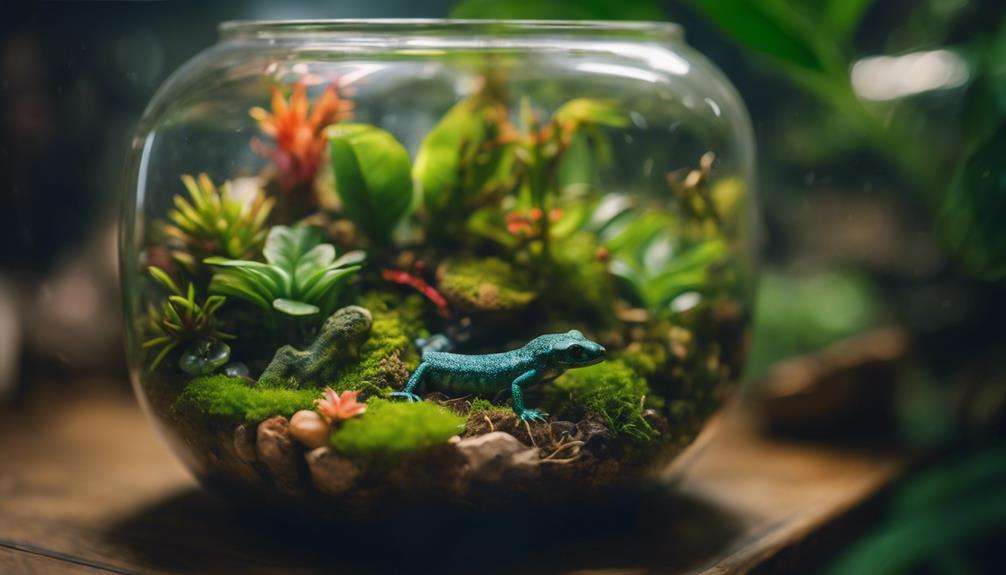
Why do exotic pet owners find salamanders so appealing?
Salamanders, including species like tiger salamanders, have gained popularity among exotic pet enthusiasts for several reasons. Their unique appearance, with vibrant colors and sleek bodies, captures the interest of hobbyists looking for visually striking pets. Additionally, the diverse range of salamander species available, each with its own characteristics and sizes, caters to the preferences of different pet owners.
The docile nature of many salamanders makes them easy to handle, adding to their appeal as pets suitable for interaction. Moreover, their adaptability to terrarium environments is a significant factor in their popularity. Salamanders' natural habitats can be recreated effectively in terrariums, providing a captivating display for owners while offering a relatively low-maintenance pet-keeping experience.
These factors combined make salamanders an attractive choice for those venturing into the world of exotic pet ownership.
Frequently Asked Questions
Can Salamanders Live in Terrariums?
Yes, salamanders can live in terrariums. Proper terrarium setup, including temperature requirements, is crucial for their well-being. Make sure to maintain the right conditions to create a safe and comfortable environment for them.
What Are the Benefits of Salamanders?
Embracing salamanders in your terrarium offers a symbiotic relationship, benefiting both creatures. Their low maintenance care requirements, diverse species, and role in ecosystem balance make them a captivating and educational addition to your habitat.
What Is a Salamander Preferred Habitat?
In their natural habitat, salamanders prefer woodland terrariums with cool, moist environments. These creatures exhibit behaviors like crawling in water dishes and hiding among ferns and moss, necessitating specific environmental requirements for their well-being.
What Makes Salamanders Unique?
Salamanders possess unique adaptations like permeable skin for respiration and regenerative abilities. Their diverse colors and patterns, nocturnal habits, courtship dances, and feeding strategies make them fascinating. Observing their behavior and reproduction characteristics in a terrarium setting enhances their allure.
Conclusion
In conclusion, salamanders are the perfect addition to your terrarium due to their low-maintenance care requirements, unique characteristics, and adaptability to various habitats.
Their peaceful nature, diverse species, and fascinating natural behaviors make them an ideal choice for terrarium enthusiasts.
Just like the intricate ecosystems they inhabit, salamanders bring a touch of wonder and beauty to your terrarium setup, creating a captivating display that will leave you in awe of the natural world.
